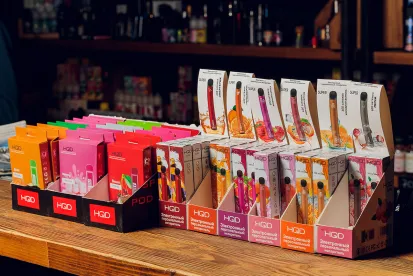Section 287 of the U.S. Patent Act gives a patent owner the ability to recover damages for patent infringement in two ways: (1) if a patented article is marked; or (2) if actual notice of infringement has been provided. The Federal Circuit’s decision last week in Lubby Holdings v. Chung emphasizes how important it is to properly mark covered products so as to maximize damages in a patent infringement lawsuit. Indeed, without proper marking, recoverable damages may be a mere fraction of what they could have been.
Pre-Appeal
The asserted patent in this case (U.S. Patent No. 9,750,284) covers vaporizers — more widely known as vape pens — purportedly resistant to leaking. Lubby sued Chung for infringement of the ʼ284 patent. The day before trial, Lubby disclosed its damages computation under FRCP 26(a)(1)(A)(iii) to which Chung immediately objected and questioned whether Lubby’s products were properly marked as required by 35 U.S.C. § 287. More specifically, in an attempt to prevent Lubby from relying on the constructive notice (patent marking) portion of § 287 (i.e., (1) in the paragraph above) for its damages calculation, Chung identified a particular vape pen product on Lubby’s website as lacking the patent number. During trial, Chung again raised the marking issue when he moved for judgment as a matter of law as to damages, but the lower court did not rule on Chung’s motion. The jury ultimately returned a verdict of infringement against Chung and awarded Lubby $863,936.10 (which accounted for sales prior to and after the lawsuit).
Appeal
Chung appealed on two grounds: (1) there was no evidence to support the jury’s verdict of direct infringement, and (2) there was a lack of substantial evidence to support the jury’s damages verdict. The appellate panel quickly disposed of the first ground citing Chung’s own admissions that he designed, made the decision to sell, and sold the accused vape pens through his company, and explaining that corporate officers can be personally liable for infringement even if the infringing acts were done in a corporate capacity.
Finding that Chung properly preserved and raised the second ground for appeal in his Rule 50 motions, the appellate panel reviewed the denial of the Rule 50 motions de novo. The majority found that, since Chung met his initial burden of production by pointing to a Lubby product without a proper patent marking, the burden shifted to Lubby as the patentee to prove that the identified product did not practice the claims of the ʼ284 patent or that it marked all the products covered by the ʼ284 patent that it actually sold. In fact, the court made it clear that the burden on the alleged infringer is not one of persuasion or proof; rather, the alleged infringer only has to put the patentee on notice that it or authorized licensees sold specific unmarked products that the alleged infringer believes practice the patent. The panel found that Lubby failed to present any rebuttal evidence that the vape pen identified by Chung did not practice the ʼ284 patent and, as such, Lubby would only be able to recover damages from the time of actual notice.
Unfortunately for Lubby, it only got worse from there. Lubby argued that Chung had actual notice well before the lawsuit was filed, at least by virtue of certain non-disclosure agreements signed by Chung relating to the technology underlying the ʼ284 patent. But the majority noted that determining actual notice under § 287 focuses on the patentee’s action, not the knowledge or understanding of the infringer. In other words, without an “affirmative communication” by Lubby to Chung of a “specific charge of infringement by a specific accused product or device,” prior to the lawsuit, actual notice only occurred once the lawsuit was filed against Chung. Accordingly, the appellate panel found that the lower court erred in not entering a judgment as a matter of law that Chung was not liable for damages prior to filing of the lawsuit.
Post-Appeal
So, what happens now? On remand, the lower court must determine the number of vape pens sold by Chung after the filing of the lawsuit and the appropriate damages award for these sales. From the two sales summaries discussed in the opinion and Chung’s representation of post-filing sales during the appeal, it seems that the revised damages award will be nominal compared to what the jury previously awarded.
Key Takeaways
While patent marking is certainly not required in the United States, failure to properly mark may come with a high cost. To be sure, failure to properly mark may significantly reduce the monetary damages that a patentee may otherwise stand to recover. Developing and maintaining a marking program is key to avoiding the financial disincentive built into § 287 for failure to mark.
In addition, the time and money that a patentee would otherwise have to expend enforcing the patent against infringers may be significantly reduced by marking. For example, since patent marking serves to notify others of the patent protecting a particular product, it may help to minimize unintentional infringement. And, the threat of a higher damages award may help to deter intentional infringement.
Marking Practice Tips
In the U.S., proper marking requires any product covered by a patent to be marked with the word “Patent” or “Pat.” followed by either (a) the appropriate patent number(s) or (b) a free, publicly accessible website address that associates the product(s) with the patent(s). For example, a virtually marked product under (b) might include the following marking:
U.S. Pat.: http://www.madeupcompany.com/patents
The website must clearly correlate each product covered by at least one claim of a patent to that specific patent or patents. In other words, the website must do more than simply list the patentee's patents. Moreover, it is important to review and update the website on a regular basis to make sure that it accurately reflects any new products and account for any recently issued or expired (or otherwise unenforceable) patents.
The patent marking on the product must be visible. This might seem obvious, but it is not unheard of for a licensee under an obligation to mark a licensed product to try to minimize or conceal the marking. It is up to the patentee to police its licensees’ compliance with marking, so it is wise to include a periodic review of the licensee’s product (or, if the product itself is not capable of being marked, the product’s label, packaging and the like) to ensure that marking is being done correctly. In this vein, be sure to clearly reflect patent marking requirements in the patent license or other contracts.
Since proper patent marking allows a patentee to potentially obtain higher monetary damages in a patent infringement lawsuit, careful attention must be given to accurately marking products by the patentee and any licensees in any relevant jurisdictions. However, each country has its own laws on patent marking, so don’t assume that a one-size-fits-all marking program will work for all jurisdictions. Finally, records related to marking should be diligently maintained in case marking is later challenged by an alleged infringer.




 />i
/>i

